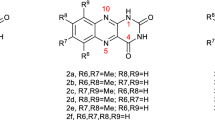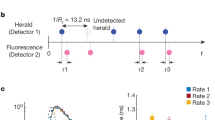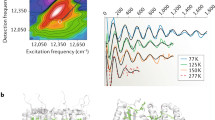Abstract
DHERE AND CASTELLI1 reported the delayed emission of riboflavin at approximately 6000 Å and described it as a phosphorescence. Szent-Gyorgyi2 found that if the phosphorescence was to be seen dissolved oxygen had to be present. Steele3 was able to measure the emission spectrum of the riboflavin phosphorescence, maximum at 6030 Å, only in the presence of dissolved oxygen. Shiga and Piette4 using electron paramagnetic resonance spectroscopy confirmed the oxygen effect and suggested that the phosphorescent emission was prolonged by an inhibition of the non-radiative triplet–singlet transition. As this effect of oxygen, increasing the lifetime of a triplet energy term, is in direct contrast with its well known marked quenching of molecular phosphorescences by shortening the lifetimes of the triplets, presumably by paramagnetic perturbation of the triplet–singlet transition, we have looked for an explanation of the paradoxical increase in the triplet lifetime of riboflavin in the presence of oxygen.
This is a preview of subscription content, access via your institution
Access options
Subscribe to this journal
Receive 51 print issues and online access
$199.00 per year
only $3.90 per issue
Buy this article
- Purchase on Springer Link
- Instant access to full article PDF
Prices may be subject to local taxes which are calculated during checkout
Similar content being viewed by others
References
Dhere, C., and Castelli, V., C.R. Acad. Sci., Paris, 206, 2003 (1938).
Szent-Gyorgyi, A., Bioenergetics, 29 (Academic Press, Inc., New York, 1957).
Steele, Richard H., Biochemistry, 2, 529 (1963).
Shiga, T., and Piette, L. H., Photochem. Photobiol., 3, 213 (1964).
Ogryzlo, E. A., J. Chem. Educ., 42, 647 (1965).
Dijkgraaf, C., Sitters, R., and Holjtink, C. J., Mol. Phys., 5, 643 (1962).
Jones, A. Vallance, and Harrison, A. W., J. Atmos. and Terr. Phys., 13, 45 (1958).
Arnold, J. S., Browne, R. J., and Ogryzlo, E. A., in Symposium on Chemiluminescence, 35 (Advanced Res. Projects Agency, Office of Naval Res., U.S. Army Res. Office, Durham, North Carolina, 1965).
Latimer, Wendell M., Oxidation Potentials, 41 (Prentice-Hall, Inc., New York, 1938).
Beinert, Helmut, in Light and Life (edit. by McElroy, W. D., and Glass, B.), 163 (The Johns Hopkins Press, Baltimore, 1961).
Gibson, Q. H., and Hastings, J. W., Biochem. J., 83, 368 (1962).
Massey, V., and Gibson, Q. H., Fed. Proc., 23, Part 1, 18 (1964).
de Duve, Christian, and Baudhuin, Pierre, Physiol. Revs., 46, 323 (1966).
Khan, A. U., and Kasha, M., J. Amer. Chem. Soc., 88, 1574 (1966).
Stauff, J., in Symposium on Chemiluminescence, 389 (Advanced Res. Projects Agency, Office of Naval Res., U.S. Army Res. Office, Durham, North Carolina, 1965).
Seliger, H. H., and McElroy, W. D., Arch. Biochem. Biophys., 88, 136 (1960).
Author information
Authors and Affiliations
Rights and permissions
About this article
Cite this article
STEELE, R., CUSACHS, L. Energy Terms of Oxygen and Riboflavin—a Biological Quantum Ladder?. Nature 213, 800–801 (1967). https://doi.org/10.1038/213800a0
Issue Date:
DOI: https://doi.org/10.1038/213800a0
This article is cited by
-
Singlet Oxygen Generation Enhanced by Silver-Pectin Nanoparticles
Journal of Fluorescence (2012)
Comments
By submitting a comment you agree to abide by our Terms and Community Guidelines. If you find something abusive or that does not comply with our terms or guidelines please flag it as inappropriate.



